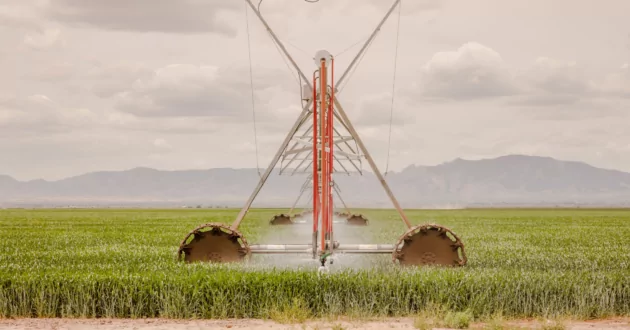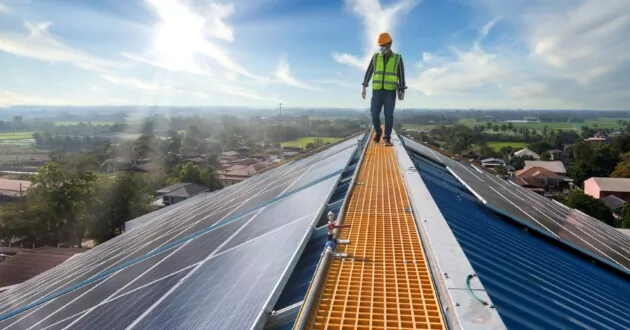<!—->
<!– –>

What do global climate change and global warming look like? Surface temperature statistics paint a compelling picture of the changing climate: 2023, according to the European Union climate monitor Copernicus, was the warmest year on record—nearly 1.5 degrees Celsius warmer than pre-industrial levels.
To gain a holistic understanding of the current climate crisis and future climate implications, however, it’s important to look beyond global average temperature records. The impacts of climate change may be organized into three categories:
- Intensifying extreme weather events
- Changes to natural ecosystems
- Harm to human health and well-being
Extreme weather events
While climate change is defined as a shift in long-term weather patterns, its impacts include an increase in the severity of short-term weather events.
- Heat waves: Dangerous heat waves are becoming more common and are one of the most obvious effects of climate change as the Earth’s temperature continues to rise.
- Droughts: Higher temperatures can cause faster water evaporation, making arid regions even more dry. Climate change-linked shifts in atmospheric circulation can further exacerbate drought conditions as rain bypasses dry regions.
- Wildfires: Droughts and faster water evaporation can lead to drier vegetation, fueling larger and more frequent wildfires. According to NASA, even typically rainy regions will be more vulnerable to wildfires and wildfire seasons are extending around the globe.
- Heavy rain and tropical storms: Climate change alters precipitation patterns, with NASA reporting more frequent periods of excess precipitation. Scientists project further increases in tropical cyclone rainfall in particular, due to greater atmospheric moisture content.
- Increased coastal flooding: Sea level rises associated with global warming are leaving low-lying coastal areas vulnerable to greater flooding, according to the Intergovernmental Panel on Climate Change (IPCC).
Changes to natural ecosystems
Due to climate change, natural ecosystems are undergoing long-term changes and declines in biodiversity. Here are a few examples:
- Sea ice loss and melting ice sheets: Declining levels of Arctic sea ice threaten the habitats of species such as polar bears and walruses. Polar bears hunt seals in the Arctic sea ice habitat while walruses rely on the ice as a place to rest when they’re not diving for food. In Greenland and Antarctica, melting ice sheets are contributing to rising sea levels, endangering coastal ecosystems around the world.
- Damage to coral reefs: Ocean temperature increases in warmer climates from Australia to Florida are causing coral reefs to lose colorful algae, leading to what’s known as “coral bleaching.”
- Ocean acidification: Marine life is also at risk from ocean acidification, stemming from greenhouse gas emissions and the greater concentration of carbon dioxide in the atmosphere. That carbon dioxide is absorbed by seawater, leading to chemical reactions that make oceans more acidic. Shellfish are especially vulnerable to ocean acidification, which NOAA describes as having “osteoporosis-like effects” on oysters and clams.
- Invasive species proliferation: Warmer temperatures allow invasive species to move to new areas, often to the detriment of native wildlife. The spread of the purple loosestrife plant in North America, for instance, has reduced nesting sites and resulted in the decline of some bird populations.
- Harm to estuarine ecosystems: Droughts reduce freshwater flows and increase salinity in estuaries, while greater precipitation increases stormwater runoff, introducing more sediment and pollution. These changes threaten the wildlife that rely on specific estuarine conditions to thrive.
Harm to human health and well-being
Climate change is increasingly impacting the quality of life on Earth, affecting people’s health and economic well-being.
- Illnesses and fatalities: Rising global temperatures foster conditions for infectious diseases to spread, and extreme weather events cause tragic loss of life as well as illnesses. Poor air quality from wildfire smoke can exacerbate asthma and heart disease, for example, while heat waves can cause heat exhaustion. More than 60,000 people died in European heat waves in 2022.
- Food insecurity: Droughts and scarcity of water supplies, severe storms, extreme heat and invasive species can cause crop failures and food insecurity. Most of those at risk of climate change-linked hunger are in Sub-Saharan Africa, South Asia and Southeast Asia, according to the World Bank.
- Financial consequences: Climate change can hurt businesses and individuals’ financial well-being. For example, changing weather patterns have imperiled wine production in California, while rising sea levels threaten the future of Caribbean coastal resorts. Meanwhile, insurance companies are increasingly declining to provide property insurance in areas vulnerable to extreme weather, leaving homeowners there at greater financial risk.
- Damage to infrastructure: Wildfires, powerful storms and flooding can damage energy grids, leading to power outages, as well as transportation networks, hindering people’s ability to access services and goods to meet their daily needs. Damage to one type of infrastructure can lead to consequences for another: As noted by the U.S. government’s National Climate Assessment, “failure of the electrical grid can affect everything from water treatment to public health.”
Hope for the future
Though some of the impacts on Earth’s climate are irreversible, a wide range of organizations from the public and private sector are working on climate actions that address the causes of climate change. These include ongoing mitigation strategies and targets for the reduction of greenhouse gas emissions, such as emissions of carbon dioxide and methane.
Meeting these targets relies in part on the growth of clean, renewable energy production that reduces the world’s reliance on energy derived from the burning of fossil fuels. Other climate science innovation could also contribute to climate change mitigation measures, ranging from carbon capture technology to methods of neutralizing ocean acidity.
Existing sustainable technologies can also help companies lower their carbon footprint. Artificial intelligence-powered analysis, for example, can help companies identify what parts of their operations produce the most greenhouse gas emissions; carbon accounting can inform their strategies on reducing those emissions.
Of utmost importance, scientists say, is acting quickly.
“If we act now,” IPCC Chair Hoesung Lee said in a 2023 statement, “we can still secure a livable sustainable future for all.”
Put your sustainability initiatives into action by managing the economic impact of severe weather and climate change on your business practices through the IBM Environmental Intelligence Suite.
Explore sustainability strategy
Learn about climate and weather risk management
Was this article helpful?
YesNo
More from Sustainability

February 15, 2024
How Kubota is changing the status quo in agriculture and sustainability with technology
2 min read – Kubota, a Japanese-based services and technology provider within the agriculture, water and environmental industries, has a keen focus on innovation and sustainability. A few years ago, Kubota aimed to tackle operational efficiency challenges, water and sewage systems maintenance issues, and staff shortages that many local companies faced. Simultaneously, it attempted to commit to its zero carbon city declaration, which aims to virtually eliminate carbon dioxide emissions by 2050. Kubota consulted with IBM® to create a system that uses AI and…

February 14, 2024
The future of renewable energy
5 min read – Renewable energy is energy produced from Earth’s natural resources, those that can be replenished faster than they are consumed. Common examples include solar power, hydropower and wind power. Shifting to these renewable energy sources is key to the fight against climate change. Today, a variety of incentives and subsidies help make it easier for companies to lean on renewable resources as a stable source of power to help alleviate the climate crisis. But the next generation of clean energy requires…

February 13, 2024
4 strategic sourcing use cases to strengthen your supply chain
5 min read – In this age of supply chain disruptions that hold the power to upend entire industries, strength and resilience across the entire value chain is no longer a nice-to-have—it’s a survival tactic. For sourcing teams, that means pivoting their mindset around selecting suppliers from a tactical, lowest-cost-above-all approach to a strategic one. Where tactical sourcing is a short-term strategy, strategic sourcing is for long-term business goals. Sourcing and procurement professionals operating with a strategic sourcing mindset assess a supplier’s quality, reputation…

February 12, 2024
Scaling scope 3 impact and measurement with IBM Envizi Supply Chain Intelligence
< 1 min read – IBM® Envizi™ is pleased to announce the release of additional functionality as we continue to build out our Scope 3 emissions accounting solution. The new Supply Chain Intelligence module, part of the IBM Envizi ESG Suite, captures and aggregates high-volume supplier and product-level transactional data along with product carbon footprint data (PCF) for the purpose of Scope 3 calculation and reporting. Transactional data, including spend, is directly integrated from the client’s ERP system. The emissions calculation engine automates Scope 3 emissions…
IBM Newsletters
Get our newsletters and topic updates that deliver the latest thought leadership and insights on emerging trends.
Subscribe now
More newsletters
- SEO Powered Content & PR Distribution. Get Amplified Today.
- PlatoData.Network Vertical Generative Ai. Empower Yourself. Access Here.
- PlatoAiStream. Web3 Intelligence. Knowledge Amplified. Access Here.
- PlatoESG. Carbon, CleanTech, Energy, Environment, Solar, Waste Management. Access Here.
- PlatoHealth. Biotech and Clinical Trials Intelligence. Access Here.
- Source: https://www.ibm.com/blog/climate-change-examples/



